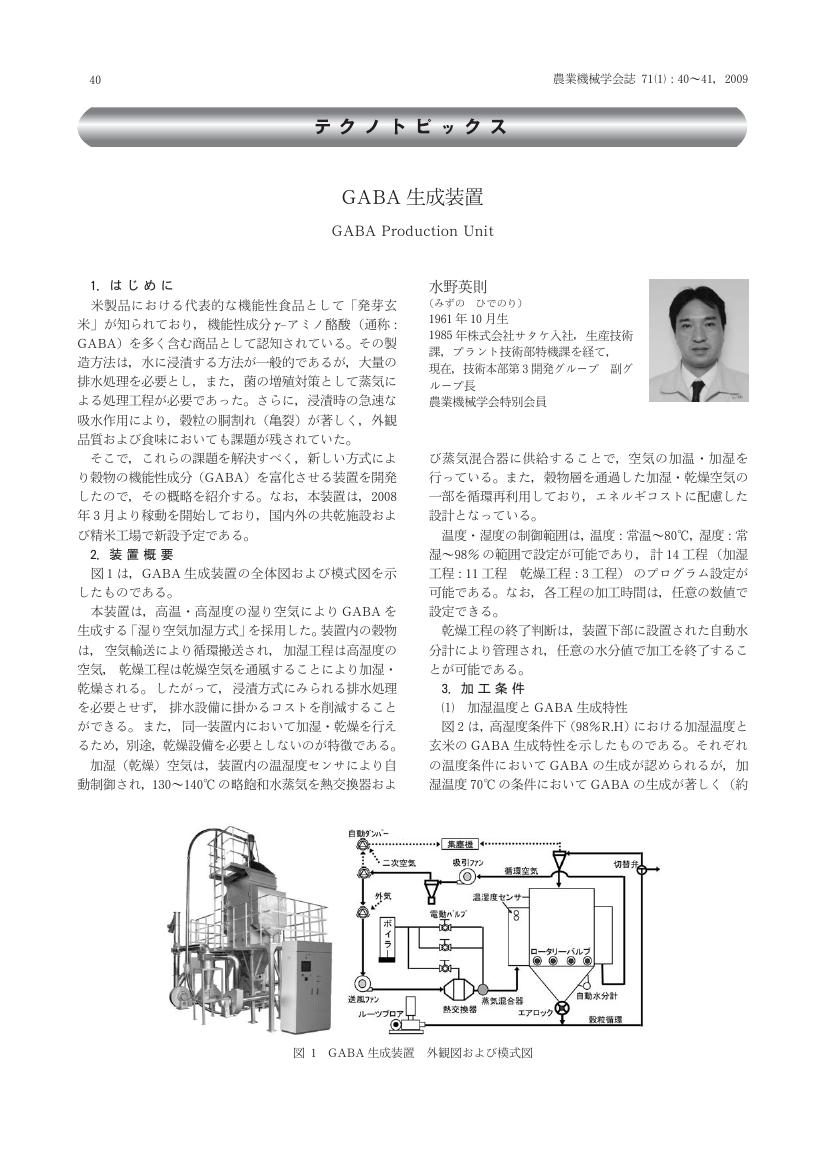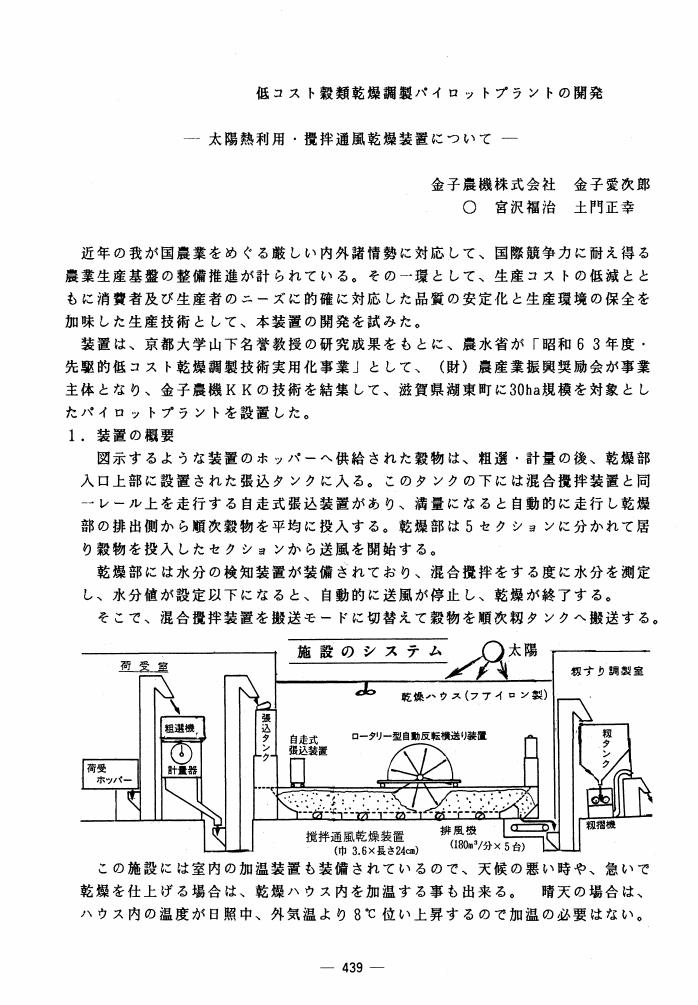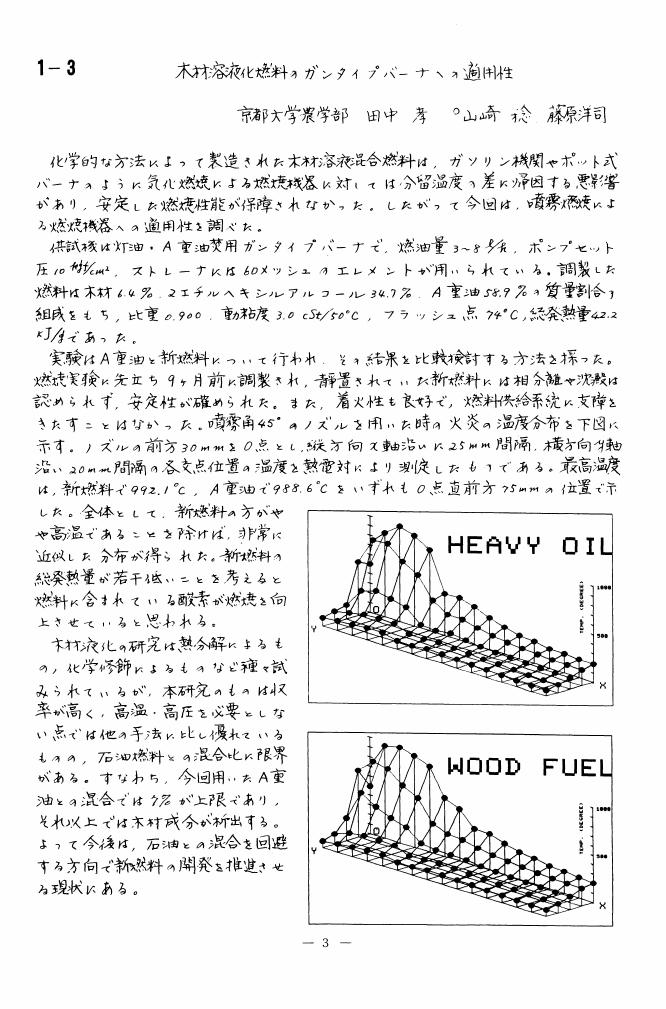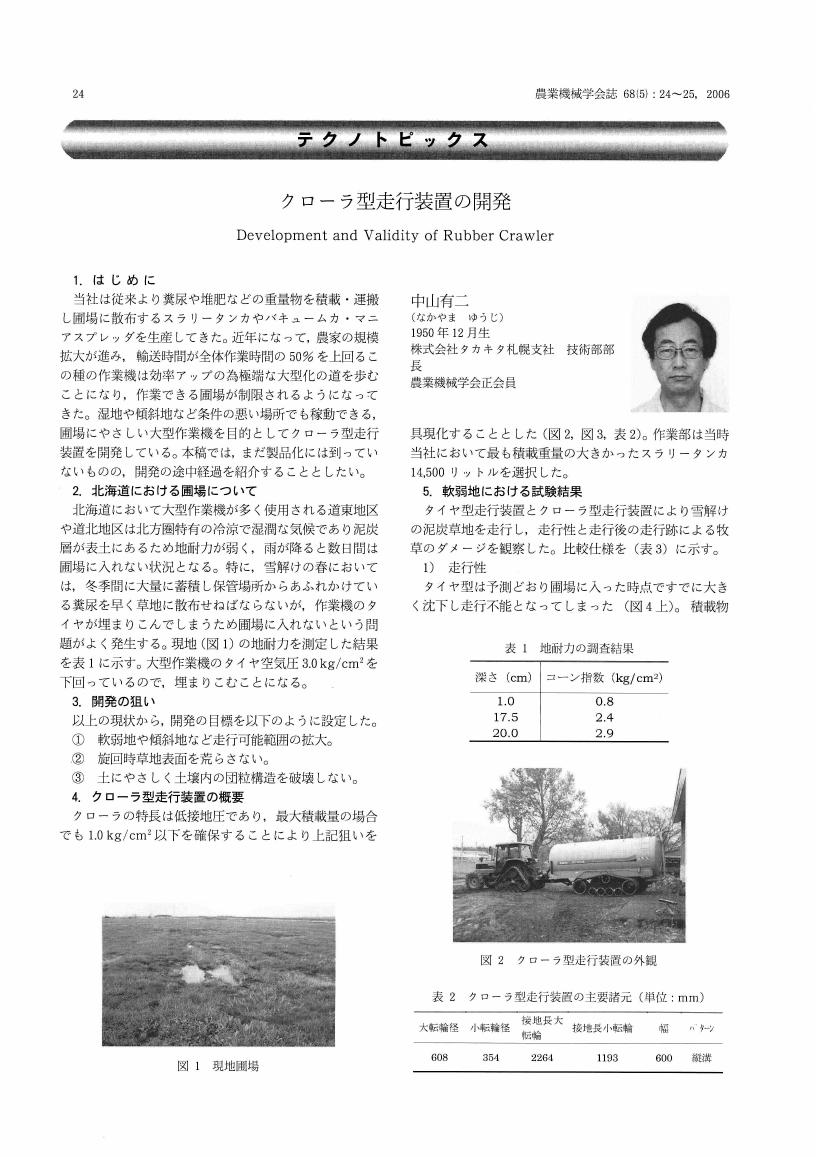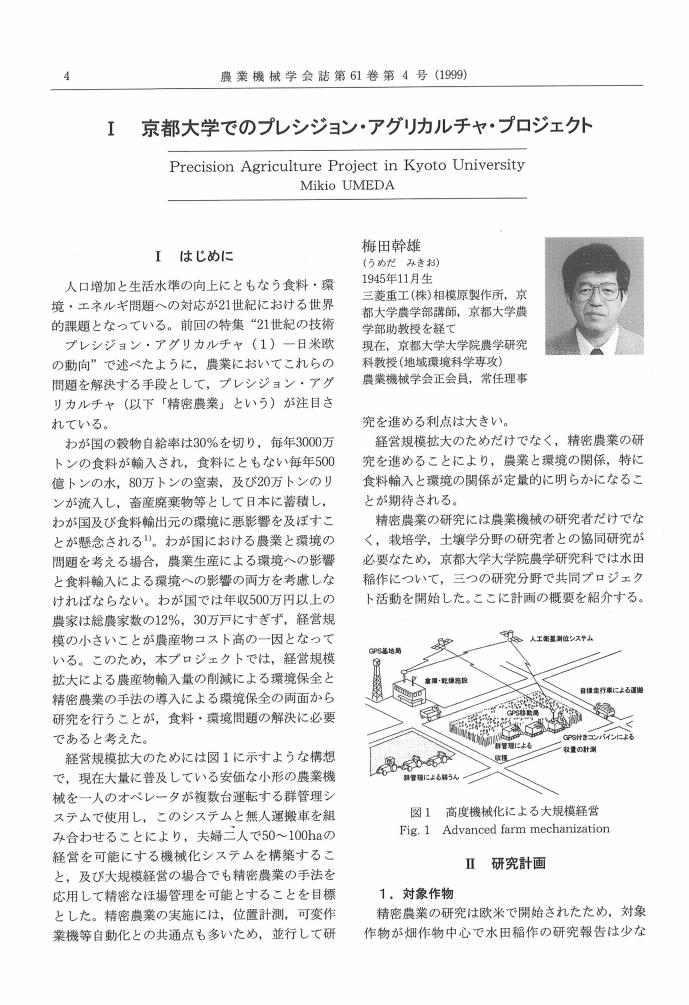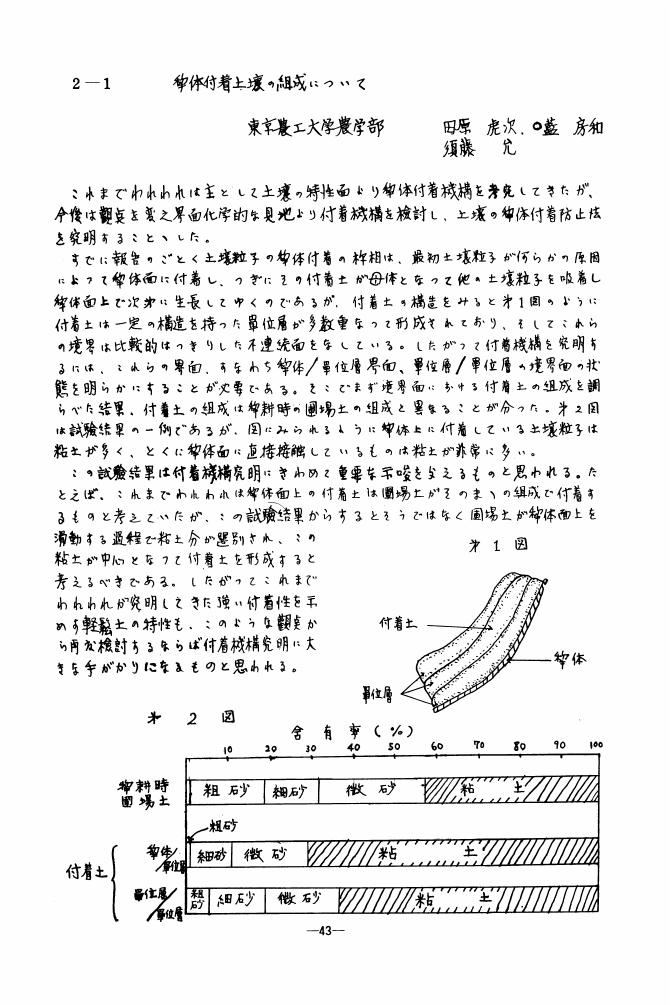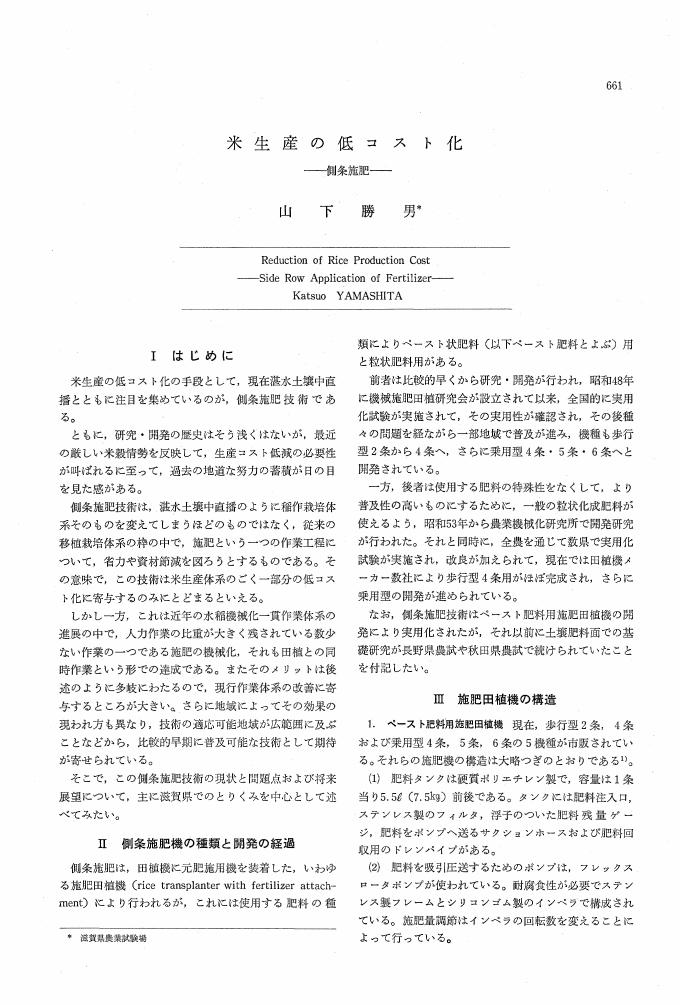1 0 0 0 OA 人工乾燥における穀物の電気的特性
- 著者
- 伴 敏三
- 出版者
- 農業食料工学会
- 雑誌
- 農業機械学会誌 (ISSN:02852543)
- 巻号頁・発行日
- vol.30, no.Supplement, pp.104-104, 1968 (Released:2010-04-30)
1 0 0 0 プラウパッカーの性能とその利用について
- 著者
- 佐藤 清美 中 精一
- 出版者
- The Japanese Society of Agricultural Machinery and Food Engineers
- 雑誌
- 農業機械学会誌 (ISSN:02852543)
- 巻号頁・発行日
- vol.27, no.1, pp.40-40, 1965
1 0 0 0 OA マルチセンシングデータ対応型生物情報解析システム
1 0 0 0 家畜ふん尿のたい肥化
- 著者
- 三浦 保 伊沢 敏彦 森本 国夫
- 出版者
- The Japanese Society of Agricultural Machinery and Food Engineers
- 雑誌
- 農業機械学会誌 (ISSN:02852543)
- 巻号頁・発行日
- vol.39, no.1, pp.93-95, 1977
1 0 0 0 OA 家畜ふん尿の堆肥化
1 0 0 0 OA GABA生成装置
- 著者
- 水野 英則
- 出版者
- 農業食料工学会
- 雑誌
- 農業機械学会誌 (ISSN:02852543)
- 巻号頁・発行日
- vol.71, no.1, pp.1_40-1_41, 2009-01-01 (Released:2011-02-14)
1 0 0 0 OA 根株処理機械の開発研究 (第2報)
- 著者
- 田中 勝千
- 出版者
- 農業食料工学会
- 雑誌
- 農業機械学会誌 (ISSN:02852543)
- 巻号頁・発行日
- vol.58, no.6, pp.3-12, 1996 (Released:2010-04-30)
- 参考文献数
- 6
片刃のナイフに作用する曲げ荷重の大きさと向きを調べることによって, 片刃のナイフ形状と実作業との関わりを検討し, 両刃と比べた場合の片刃の利点を示した。また, 切断時に片刃の切刃に発生する曲げ応力について, 刃面圧力センサの測定値を用いる方法と, 抵抗線歪みゲージをナイフに直接接着し, 測定された曲げモーメントを用いる方法の二通りで求め, 切刃の形状を検討した。刃先角が小さいほど曲げ応力は大きく, 刃先角25°のナイフでは300MPaとなった。切刃先端の強度を維持しつつ切断力を低減するために, 片刃の切刃の形状を二段刃とすることを提案した。
1 0 0 0 OA 北海道における農作業事故の分析
- 著者
- 高井 宗宏
- 出版者
- 農業食料工学会
- 雑誌
- 農業機械学会誌 (ISSN:02852543)
- 巻号頁・発行日
- vol.37, no.3, pp.425-431, 1975 (Released:2010-04-30)
- 参考文献数
- 6
Number of death and injury from the farm accidents in Hokkaido increases exponentially by year in proportion to the propagation of large farm machinery. The death and injury rate are 1.9 and 27.5 respectively per 10, 000 workers in 1974.This analysis was held to get information for safety work which is derived from 1663 accident cases in last two years.1) About 9% of the reported accidents are the animal-related injuries. And apporoximately 12% are occurred in burn and other structures around farm, and most of them are slip or falls of the workers (Table 2).The remaining 79% are the machine-related injuries (Table 3, 6, 7).2) The tractor and it's implements are involved in 36% of the total injuries. Over-turns and runover of the tractor have the highest fatality rate for the machine-related injuries. While transporting job are involved in 11%, and over two third of them are due to falls on the different level.The remaining 31% are due to stationaly or selfpropelled machines.3) Less than a third of all injuries were due to “falls” of man on the same or different level, and being “struck by” or “caught in” the machine parts accounted for nearly another one third of the all injuries.4) The information of labour scientist will be a great help in producing the program of accident prevention.
1 0 0 0 OA 低コスト穀類乾燥調製パイロットプラントの開発
1 0 0 0 OA 木材溶溶化燃料のガンタイプバーナへの適用性
1 0 0 0 OA 農鍛冶における鍛造方法 (第2報)
- 著者
- 佐藤 次郎
- 出版者
- 農業食料工学会
- 雑誌
- 農業機械学会誌 (ISSN:02852543)
- 巻号頁・発行日
- vol.34, no.4, pp.385-391, 1973-03-01 (Released:2010-04-30)
- 参考文献数
- 9
With the progress of power farming, the number of farmer's blacksmithies has been decreased every year, as their main jobs ars to produce and repair Japanese-hoes. But I believe that their traditional technique is unique and excelent, and worth transmiting.Following is the representative process and technique of producing Japanese-hoes by farmer's blacksmithies in Fukushima prefecture.1) SS4IP, soft steel is used most often as the base steel of the hoes. Tamahagane (steel made from iron sand), Nabehagane (pan-bottom substitute for steel) and Zenihagane (coin substitute for steel) are used as the substitute for hard steel, and Nabehagane is used most often among them. Nabehagane and Zenihagane, so called by farmer's blacksmithies, are both old cast irons.2) Pine-charcoal or Chestnut-charcoal are always used in forging, as the temperature of heating rises rapidly with them. Most tools for forging are self-makes by farmer's blacksmithies.3) Ordinarily, Japanese-hoes are made through five steps, that is, preparing, cutting, forging, quenching, and finishing, and the process consists of eighteen unit operations. The main operations of them are marking-off, chiseling, drowing down, teyori (twisting), tewari (cutting), forge welding, and quenching. The operation of forge welding consists of crushing Zenihagane of Nabehagane into small pieces, placing them on the base steel, and melting them by heating over 1100°C. After then the welded steel is forged ten to twelve times. Quenching is the operation of heating the hoe up to 850°C and putting it into water of 30°C. Forge welding and heat treatment are the most delicate techniques in making hoes.
1 0 0 0 OA クローラ型走行装置の開発
- 著者
- 中山 有二
- 出版者
- 農業食料工学会
- 雑誌
- 農業機械学会誌 (ISSN:02852543)
- 巻号頁・発行日
- vol.68, no.5, pp.24-25, 2006-09-01 (Released:2010-11-19)
- 被引用文献数
- 1
1 0 0 0 OA 農産施設のコストE. に関する研究 (第10報)
1 0 0 0 OA 京都大学でのプレシジョン・アグリカルチャ・プロジェクト
1 0 0 0 OA レンコン収穫工程からみた噴流式レンコン掘取機の検討
- 著者
- 遠藤 俊三 芝野 保徳
- 出版者
- 農業食料工学会
- 雑誌
- 農業機械学会誌 (ISSN:02852543)
- 巻号頁・発行日
- vol.44, no.Supplement, pp.91-91, 1982-07-01 (Released:2010-04-30)
1 0 0 0 OA 家畜鳴声の特性解析
1 0 0 0 OA 犂体付着土壤の組成について
1 0 0 0 OA 米生産の低コスト化
- 著者
- 山下 勝男
- 出版者
- 農業食料工学会
- 雑誌
- 農業機械学会誌 (ISSN:02852543)
- 巻号頁・発行日
- vol.46, no.1, pp.661-664, 1984 (Released:2010-04-30)
- 参考文献数
- 5
1 0 0 0 OA 畜産2
- 著者
- 小栗 克之
- 出版者
- 農業食料工学会
- 雑誌
- 農業機械学会誌 (ISSN:02852543)
- 巻号頁・発行日
- vol.51, no.2, pp.131-134, 1989 (Released:2010-04-30)
1 0 0 0 OA 大学は特許制度と特許情報にもっと関心を
- 著者
- 中村 友之
- 出版者
- 農業食料工学会
- 雑誌
- 農業機械学会誌 (ISSN:02852543)
- 巻号頁・発行日
- vol.46, no.2, pp.261-263, 1984 (Released:2010-04-30)



